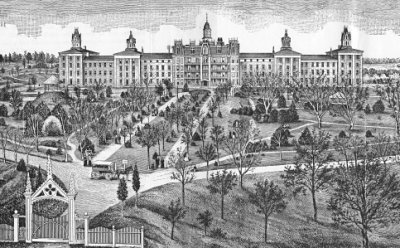
The State Lunatic Asylum in Fulton, Missouri. The asylum opened in 1851, four years before the Fulton became the site of Celia's murder trial.
| 1821 | Under the Missouri Compromise, Missouri is admitted to the Union as a slave state and the expansion of slavery in the Louisiana Territory is limited to states south of Missouri. |
| 1822 | Sometime before the fall of 1822, the Robert Newsom family settles land on the Middle River in southern Callaway County, Missouri (about 9 miles south of Fulton). |
| 1850 | Celia, age 14, arrives from neighboring Audrain County to become Robert Newsom's first female slave, joining five male slaves on his 800-acre farm....Callaway County's population is 13,827, including 9,895 whites. |
| 1850-1855 | Robert Newsom, age 60, rapes Celia in 1850 and continues to demand sexual relations from his slave girl over the course of the next five years. Celia gives birth to two children, almost certainly fathered by Newsom. Her main duty on the farm seems to be that of cook....Sometime before 1855, Celia enters into a romantic relationship with George, another one of Newsom's slaves. |
| 1855, Winter | Celia becomes pregant again, either carrying the child of Newsom or George, her lover. George demands that Celia stop having sex with Newsom. |
| June 23, 1855 | Newsom, having rejected Celia's plea that he stop having sex with her, tells Celia "he was coming to her cabin that night." At about 10 p.m., Newsom leaves his house and walks the fifty yards over to Celia's cabin. When Newsom advances toward Celia, she strikes him on the head with a large stick. He falls from the blow and Celia hits him on the head on second time, killing him. She places Newsom's body in her fireplace and lights a fire. |
| June 24, 1855 | Celia asks Coffee Waynescot, Newsom's 12-year-old grandson, to spread ashes from the previous night's fire along a path to the stable....The Newsom family, concerned about Newsom's disappearance, begins an investigation. William Powell, leader of the search party, questions George, who tells him "it is not worth while to hunt for him except around the house." George tells Powell "he believed the last walking [Newsom] had done was along the path" leading to Celia's cabin. Powell and others search Celia's cabin, but find nothing. Confronting Celia, she initially admits that Newsom came to her cabin seeking sex, but claims that after she struck him he left. After more intense questioning, she confesses. |
| June 25, 1855 | Celia is arrested. Two justices of the peace conduct an inquest into Newsom's murder. At the inquest, William Powell, Coffee Waynescoat, and Celia provide sworn statements concerning the murder. A six-person inquest jury finds probable cause to charge Celia with the murder of Robert Newsom. |
| Summer of 1855 | The slavery question heats up in Missouri and Kansas as pro-slavery and anti-slavery forces clash in each state. |
| October 6, 1855 | John Brown arrives in Kansas to join his sons in the battle for a slave-free Kansas. |
| October 9, 1855 | The trial of Celia opens in the Callaway County Courthouse in Fulton in the courtroom of Judge William Hall. A twelve-person, all-white, all-male jury is chosen. |
| October 10, 1855 | Witnesses present testimony in the trial of Celia. The defense presents evidence that the murder was committed in self-defense. Judge Hall denies the defense's request to instruct the jury that the killing was justifiable if done to prevent a sexual assault. The jury returns a verdict of guilty. |
| October 11, 1855 | Defense lawyers move to set aside the jury verdict and grant a new trial. |
| October 13, 1855 | Judge Hall denies the motion for a new trial and sentences Celia to be "hanged by the neck until dead" on November 16. Judge Hall refuses to issue an order staying execution until Celia's appeal could be heard by the Missouri Supreme Court. |
| November 11, 1855 | On the night of November 11, five days before her scheduled execution (and with no decision yet made on her appeal to the Missouri Supreme Court), Celia escapes from the Callaway County jail. |
| Late November 1855 | Celia is "returned" to jail, probably by the people who aided in her escape. A new date, December 21, is set for her execution. |
| December 6, 1855 | Defense lawyers for Celia write a letter to Judge Abiel Leonard, a newly elected member of the Missouri Supreme Court, arguing that the refusal of Judge Hall to give certain requested instructions constituted reversible error in Celia's case. |
| December 14, 1855 | As slavery issues dominate the headlines in both Missouri and Kansas (where a full-scale civil war threatens to erupt), the Missouri Supreme Court considers and rejects Celia's appeal. |
| December 20, 1855 | Celia is questioned in her cell and again claims that she alone was responsible for Newsom's death. She tells her interrogators "as soon as I struck him the Devil got into me, and I struck him with a stick until he was dead." |
| December 21, 1855 | At 2:30 P.M., Celia is hanged in Fulton, Missouri. |
